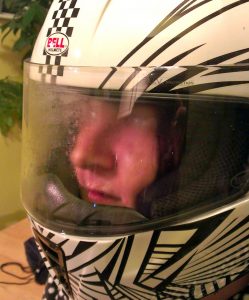
As the weather turns cold and we have more wet days, the bane of all bikers strikes – a motorcycle visor steaming up. And if you wear glasses, they’ll mist up too, double trouble. Visibility drops to zilch and riding becomes a nightmare. The simplest solution is of course to stop breathing. However, I tend to find this detrimentally affects my riding, especially on long rides…
Stop helmet fogging – the cause
Cold air, wind chill and rain dramatically reduce the temperature of the inside surface of your helmet visor and your glasses, such that moisture in the air you exhale condenses on these surfaces causing them to mist up. This condensing moisture forms tiny water droplets that scatter light and reduce the ability of a visor or glasses to transmit contrast.
How to stop visor steaming up
Solutions
There are many solutions you can try, all of which tackle the issue in one of a few ways:
- Ventilation. Increasing it and/or directing it to take exhaled air away out of your helmet. This is why steaming up is a bigger problem when stationary
- Maintaining visor surface temperature, to prevent moisture condensing
- Anti-fog coatings that stop water droplets from forming
Let’s now look at the various solutions in practice.
Open Your Visor
Yeah, pretty obvious, but opening your visor means exhaled air doesn’t hit it and the increased ventilation forces moisture away. A bit crap at high speed or in the rain and no use if you wear glasses. Most helmets have notches to leave the visor open just a bit. This is a good compromise to increase ventilation, yet still, ward off the rain a reasonable amount. Otherwise, a cable tie around the chin or your helmet can keep the visor open a fraction to achieve the same.
The downside with this plan is rain can seep down the inside of your visor and splash onto your glasses. Neither of which you can wipe easily and hinders visibility almost as much as fogging up.
Increase Ventilation
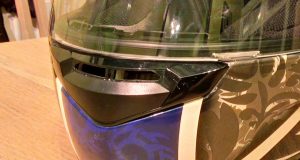
Open all your vents, especially those around the chin to help blow exhaled air away from the visor. But be wary of too strong a blast of air, I have an AGV K5 that has a massive chin vent that can send such a huge blast of cold air in, it actually chills the inside surface of my visor Pinlock and glasses, making things worse!
If you have a removable lower chin skirt piece, try ditching it to allow exhaled air to escape down. But, do be wary of too much cold air coming up instead. If your helmet has an optional nose guard, use it to help direct exhaled air down and away from the visor.
Similarly, with any neck buffs stopping air escape down, adjust them to allow airflow. I also find if I wear a buff over my face, it will direct my exhaled air up to my glasses causing them to steam up.
Pinlock Insert
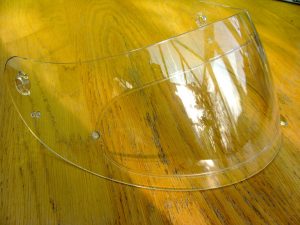
The holy grail of anti-fogging tech. Essentially a second visor stuck on the inside of your main visor, that acts like double glazing. They’re held in place by two pins on the sides of the visor that force the Pinlock to flex firm against the inside of the visor. The Pinlock’s inside surface stays warmer thanks to a sealed bubble of air between it and the main visor, so no moisture condenses on it. Pinlock visors are incredibly effective, simple to fit, and generally cost no more than £30-40. They are often supplied as standard or come ready fitted on many higher-end helmets. For most other helmets they’re an optional item you can purchase, but they aren’t available for all helmets.
Pinlock inserts do need regular maintenance to ensure they maintain a good seal, otherwise cold air and moisture can build up between the layers. Care is needed when you clean a Pinlock, they can scuff very easily if you don’t use a very soft microfibre cloth.
More details on the Pinlock site.
Find a Pinlock visor insert for your helmet at SportsBikeShop
Raleri FogStop
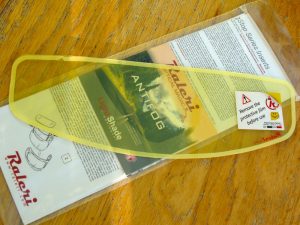
A similar insert to the Pinlock, but designed to stick on the inside of any visor. It doesn’t need the Pinlock bolts in the visor so is a good alternative to fit any face shield you have or for helmets where no Pinlock is available.
Unlike Pinlocks, I’ve found the self-adhesive seal on the Releri FogStop remains effective for several years with little or no maintenance.
Read my full review of the FogStop inserts here.
Respro Foggy Mask
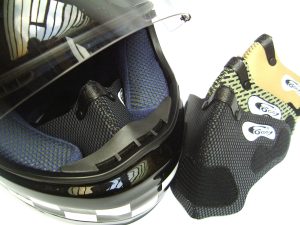
This neoprene mask can stop helmet fogging by fastening to the inside of your helmet and covering your mouth and nose, to guide exhaled air down away from the visor and glasses. A well-rated and cheap option, but not compatible with flip-up helmets.
These Respro masks can also tackle inhalation of air pollution as well as visor steam up. The way they grip the nose can also help prevent warm breath from fogging up your glasses too.
Anti-Fog Treatments
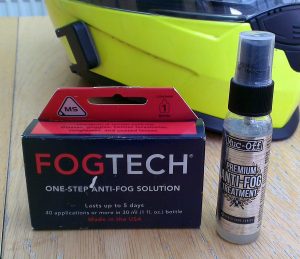
There are a number of different Anti-fog products you can apply to your visor and glasses to help avoid them misting up. These will either be hydrophobic or hydrophilic.
- Hydrophobic – a soap-based coating that repels water, preventing misting
- Hydrophilic – that attracts and absorbs water droplets to stop fogging
On the market, you’ll find countless different products, from Carnauba wax, Fogtech, Muc-Off Anti-Fog, Shift It Anti-Fog and so on.
The advantage with many of anti-fog treatments is they can also be applied to your glasses
The advantage with many of these is they can also be applied to your glasses, very useful off your bike to avoid steamed-up specs when you park up and walk inside from a cold outside. Also on your internal sun visor which can be invaluable to block out the low winter sun but equally steams up all too easily. However, most of these hydrophobic treatments are soap-based and so need regular reapplication every couple of days to remain effective.
Buy Muc-Off Premium Anti-Fog Treatment from SportsBikeShop
Check out our comparison of anti-fog treatments, where we test their effectiveness to find the best.
Stop Glasses Fogging Up
For glasses wearers, preventing your helmet visor from steaming up is only half the story. Stopping glassing from fogging up is just as crucial and less straightforward as there is no Pinlock or similar insert for your glasses! An easy first step is ensuring your glasses are nice and clean, dirt and dust on your glasses lenses help water condense into droplets that steam them up.
The above anti-fog treatments are all equally applicable to glasses as they are visors, but there are many old wives tales about using random household stuff too. For example, dishwasher rinse aid (I had little success with this one) or wiping the starch from sliced potatoes on your glasses or visor (I wouldn’t recommend this either). A more reputable solution is washing your glasses in soapy water which leaves behind a thin surfactant film that reduces the surface tension and causes the water molecules to spread out evenly into a transparent layer. Simply wash the lenses in a soapy water solution, shake off any excess, then leave them to dry or use a soft cloth
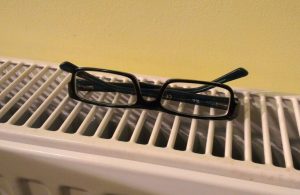
A final tip for glasses wearers, is it try and maintain the temperature of your glasses to prevent water vapour condensing in the first plate. I find this strategy works well: When setting off, go outside into the cold and get your bike unlocked and ready to go, then go back inside to gear up. Place your glasses on a warm radiator whilst donning your helmet and gloves, then put back on the now warm glasses and shut your visor before returning outside into the cold air. If you now keep the helmet shut, your glasses should remain warm enough to avoid any moisture condensing on them. Normally, I would have been outside long enough for my glasses to cool right down, so they would instantly steam up when I put my helmet on. I’m then stuck in a cycle of opening the visor to de-mist them but cooling the glasses down so they mist up again as soon as I close the visor… With the above plan, you avoid this vicious circle, at least for a few miles.
Stop Helmet Fogging Up Conclusion
Above are many approaches on how to stop your visor steaming up that you can try, each with different pros and cons, some better than others. A steamed up visor and glasses can now be a thing of the past, allowing you can concentrate on riding and see where you’re riding! It may be cold and wet out, but with the right gear, you can still have a blast on the road.
6 replies on “How to Stop Helmet Fogging Up & Visor Steam Up”
Internal visor mists up?
I got so frustrated with my glasses steaming up all the time in winter that I got rid of them altogether, I now wear contact lenses, best thing I ever did.
Pinlock visor inserts very dangerous when they stop working well. They are great when they work, but they don’t work for long. I don’t know what caused them to stop working but they don’t last more than a few months until the seal stops working properly and you fog up the visor under the pinlock.
This is horrible because you can’t wipe it away and it doesn’t go away easily by opening the visor… you sort of have to take your glove off, get your nail under the bottom and separate it from the visor to let the air flow get rid of the fog, it’s so dangerous.
Also all my pinlocks (Of which I’ve had around 6 in replacements and various helmets) start to fog up on the actual pinlock surface around my nose where I exhale. Yes…. actually on the plastic insert which isn’t supposed to be possible.
I think it might also stop working if it ever gets wet as well, so if it’s raining and you’re going slow and need to cool down because your breath is so hot…. it’ll get wet and then stop working.
I really can’t figure it out, I think I’m just going to end up buying one every few months…. and at £20-£30 each that’s expensive! I don’t really have any other choice though.
You need to regularly maintain your pinlock. Every couple of months, remove it, clean everything and refit. See my Pinlock maintenance guide here. Yes, though don’t last forever, they do need a bit of TLC now and again, but look after them and they can improve your visibility no end.
Alternatively, check out the Raleri Fogstop inserts, which have adhesive to secure them, which I’ve found to last longer.
I don’t know about you guys but I wipe down my visor every day. I can’t stand seeing spots on the visor while I’m riding.
Forget all those tips – we all know none of them fix the problem. I now actually enjoy riding in the rain looking out at all that wild weather through a perfectly clear visor – and perfectly clear specs. I close all the vents and exhale all my air through a 100mm long tube with an ID of 6mm and 2mm thick wall. I have a very small funnel with an ID of 4mm into one end of the tube and fashioned to fit my lips. at the other end I have a 3mm hole drilled horizontally through the tube in case the end of the tube happens to touch against something. I happen to have a chin spoiler in my flip up helmet so the tube sits comfortably inside my helmet with the end protruding such that I can easily position it between my lips when needed. I have ridden with ease for 250km with it in my mouth the whole time, breathing in through the nose and out through the tube. When the traffic was pulling over with their hazards going, I was sailing past, semi-trailers and all. I humbly accept all your grateful thanks in advance.